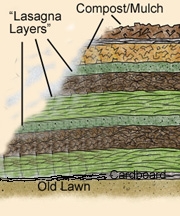
The process I use is called sheet composting, and it is simply a method of building a compost pile in place. You can not only use this procedure on well-turned vegetable beds but also on a lawn, or part of a lawn, that you would like to use differently.
I gather materials for sheet composting throughout the year so that by fall I have a big pile of clean cardboard. I avoid the type of cardboard with slick sides because it takes longer to break down and contains clay. I also gather dried leaves, newsprint, decaying plants without seeds, some compost and aged chicken manure. In short, I use the same materials you would use in a compost or worm bin.
If you plan to sheet compost in an area that has never been dug, then turn the soil to a depth of two feet. This process aerates the soil so air and water will move through it more easily. If you are sheet composting in a grassy area, then loosen and turn the sod over so it will die. You will build your pile on top.
If I have old vegetable plants still in the beds, I cut them up and leave them in place. I may also put some kitchen waste on top of that. Then I build alternating layers, as if making lasagne. You can use whatever organic materials you have. I usually use cardboard, leaves and newsprint (laying them out in sheets – no need to cut up) or shredded paper. Then I repeat the layers. I top off the pile with aged compost and chicken manure. If my garden plot has diminished in height during the growing season, I may add more clean soil or compost when I construct the layers. I moisten each layer, then wet everything again. Then I cover with a plastic tarp, making sure it is secured on the sides so it does not go flying in the wind.
Watering each level is important because it encourages the microbes and other creatures to wake up and go to work. The red wigglers used in worm composting will start to move in and munch on the foods they love. They especially like cardboard and will move inside the corrugation. They enjoy the glue that keeps the cardboard together, and I often find that the cardboard layer disappears first.
Depending on the rain, you may not have to water the pile during the winter. However, it is a good idea to check the pile from time to time and water again if necessary to keep the layers moist.
In late April or early May, remove the plastic and see what has happened to your compost pile. It should be full of red wigglers and other creatures, and you may see some little white bugs hopping around. These creatures worked the pile for you, so you don’t have to do spring digging. As they worked through the compost, they turned the soil for you.
Sometimes the cardboard or other items are not completely decomposed by spring. I plant in the bed anyway by cutting holes in the cardboard where I want my plants to grow. On other occasions, I have covered the soil with cardboard and cut holes for my plants. This cardboard layer helps conserve soil moisture.
I once sheet-composted a bed in July and covered it with plastic. In late September I removed the plastic and found no trace of the materials I had layered just a few weeks before—only a bed of wonderful soil.
The droppings that the worms leave behind (known as worm castings) are beneficial to plants. They are a mild natural fertilizer containing all the trace elements. Some call these castings “worm gold.” It sells for about $600 a yard. When I plant in the spring, I do dig in some more chicken manure and worm compost from my worm bins.
Napa County Master Gardeners welcome the public to visit their demonstration garden at Connolly Ranch on Thursday mornings, from 10:30 a.m. until noon, except the last Thursday of the month. Connolly Ranch is at 3141 Browns Valley Road at Thompson Avenue in Napa. Enter on Thompson Avenue.
Master Gardeners are volunteers who help the University of California reach the gardening public with home gardening information. Napa County Master Gardeners ( http://ucanr.org/ucmgnapa/) are available to answer gardening questions in person or by phone, Monday, Wednesday and Friday, 9 a.m. to Noon, at the U. C. Cooperative Extension office, 1710 Soscol Avenue, Suite 4, Napa, 707-253-4143, or from outside City of Napa toll-free at 877-279-3065. Or e-mail your garden questions by following the guidelines on our web site. Click on Napa, then on Have Garden Questions? Find us on Facebook under UC Master Gardeners of Napa County.